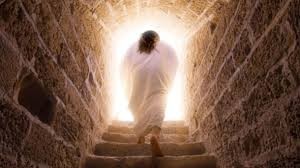 The Resurrection. If Jesus dies but does not return from the dead, then he is either a liar or a hoax. However, if he rises from the dead as predicted, then He is exactly who He claimed to be, and is Lord over all. Everything hinges on it.
The Resurrection. If Jesus dies but does not return from the dead, then he is either a liar or a hoax. However, if he rises from the dead as predicted, then He is exactly who He claimed to be, and is Lord over all. Everything hinges on it.
Clearly, this is the biggest event in the history of humankind. Isn’t it interesting, therefore, that none of the Gospel writers actually wrote about the resurrection itself? Isn’t it a bit strange that neither Matthew, Mark, Luke, or John provided us with any details of this monumental event? Why wouldn’t they tell us about the moment that Jesus opened His eyes? Why don’t we read about explosions or bright lights shining out past the stone that covered the entrance? Why is there no description of life flowing again in Jesus’ body? Why were they so silent about the most intriguing moment of Christianity?
In my opinion, the answer to these questions points to an incredible truth behind the Gospel accounts.
Over the years I have heard well-meaning Christians “fudge” a bit when it comes to sharing stories and testimonies. Perhaps someone is sharing their own faith story and in retelling the event they will enhance it a bit. They’ll make it sound a little better than what really took place. I know this is true because I’ve been present when some of the events took place and when I’ve heard them retold I was a little surprised because that’s not how I had remembered them. I suppose that’s easy for people to do. We tend to exaggerate. I don’t think Christians should do this, but I know that it happens.
This is what makes the Gospel accounts so rich – the authors didn’t give in to the temptation to tell us things that weren’t true. John even told us that he wrote his account because he had hoped people would become believers (John 20:31). Yet, even though he wanted people to become Christians, he was just as committed to telling the truth. He wrote with integrity.
One obvious reason why the Gospel authors didn’t give us details of the resurrection is because they weren’t present when it had happened. They had not witnessed the event and may not have known how everything went down. Therefore, they avoided writing things that may not have been true – even if those things would have seemed attractive to people.
Probably well over one hundred years after the crucifixion of Jesus, a letter called the Gospel of Peter was written. Because the author didn’t tell the truth about who he was the letter was never included in our New Testament. What is interesting about this false gospel is that the author couldn’t resist the temptation to do what the genuine gospel writers refrained from doing. That is, the author of the Gospel of Peter gives us a description of the resurrection scene. He said that the heavens opened up and two men descended to the earth. These two men went into the tomb and exited with Jesus. The trio was followed by a cross, which also walked out of the tomb. The two men’s heads reached the heaven while Jesus’ own head surpassed the heavens. A voice from heaven spoke and the cross replied by saying, “yea.”
This story of the resurrection was obviously meant to impress the readers. However, the account strikes me as nothing short of a mythical-styled lie.
I believe that most people are impressed with integrity even if the truth lacks some detail. It is for that reason that I believe the Gospel writers stuck with the truth. The fact that they didn’t give us sexy details tells us that they were committed to the truth. It makes their writings seem even more credible.
I think we should all stick with the truth.
peace,
dane
Dane Cramer is a backpacker, Christian blogger, jail chaplain, amateur filmmaker, and author of two books: Romancing the Trail and The Nephilim: A Monster Among Us.